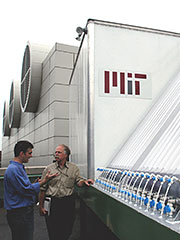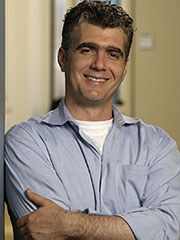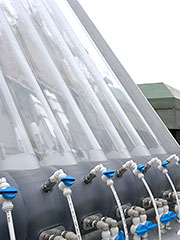Algae system transforms greenhouse emissions into green fuel
For the past year, exhaust from MIT’s main power plant has been bubbling up through tubes of algae soup. The result? A dramatic cut in carbon dioxide (CO2) emissions—and abundant algae that can be turned into biofuel for the power plant or a diesel vehicle. Utility companies have been watching field trials of the algae-soup system with keen interest, hoping to combine low-cost exhaust cleanup with renewable-fuel production.
This novel technology is the brainchild of Isaac Berzin, founder and chief technology officer of GreenFuel Technologies Corp., which markets the system. As an MIT postdoc in chemical engineering, Berzin became intrigued with using algae to clean up exhaust from power plants burning fossil fuels, especially coal. Coal is an abundant resource but an undesirable fuel because of its high CO2 emissions. “Other types of emissions can now be controlled,” said Berzin, “but controlling CO2 at low cost is still a challenge.”
One option is algae. These fast-growing, single-celled organisms gobble up CO2 during photosynthesis. Moreover, they split nitrogen oxides—a precursor to smog—into harmless nitrogen and oxygen. And they’re hardy creatures, thriving in conditions ranging from the Antarctic to the Yellowstone geysers to the Great Salt Lake.
The installation on MIT’s 20-megawatt cogeneration plant demonstrates their abilities. Atop the plant are thirty 3-meter-high triangles of clear pipe containing a mixture of algae and water. Bubbling the plant’s flue gases through the mixture has reduced CO2 emissions by 82 percent on sunny days and 50 percent on cloudy days (during daytime) and has cut nitrogen oxides by 85 percent (on a 24-hour basis).
The story gets even better. Algae double in mass every couple of hours, so they can be harvested and easily converted into biodiesel, a clean, storable fuel to use in the power plant or a diesel vehicle. Of course, burning the algae releases the carbon they captured from the flue gases. “All the original carbon will ultimately reach the environment, but you’ll have run the vehicle as well as the power plant,” said Berzin. “Put simply, you’ve created two amounts of energy with one amount of pollution.”
Using algae to capture CO2 isn’t a new idea, but no one has found a commercially viable method of doing it. What’s Berzin’s secret? “We give an old idea a push with technology,” he explained.
For example, Berzin and his coworkers “tailor” algae to perform well at a specific power plant. They use a terrestrial cousin of a miniature bioreactor designed for the International Space Station. As algae grow inside the bioreactor, their environment is gradually shifted to conditions they will encounter at the plant. Within three months, the tailored algae are thriving on flue gases instead of air. No genetic engineering is involved. “We just use the natural tendency of algae to adapt to any environment,” said Berzin.
In fall 2005, the algae system was installed at a 1000-MW power plant in the Southwest. Initial field trials at the plant were successful, and testing is now moving into a pilot phase. Berzin estimates that more than 1000 power plants in the United States have enough flue gas, water, and land to host a commercial-scale installation. Many other industrial facilities would no doubt also qualify.
Berzin credits much of his success to MIT, where he collaborated with experts ranging from bioengineers to manufacturing specialists. Among his biggest supporters was Peter Cooper of MIT's Department of Facilities, who oversaw the cogeneration-plant installation. While there's no real opportunity for significant scale-up at MIT, the MIT "beta test" is demonstrating the system's technical viability and potential business advantage. "It's performing even better than we expected," said Cooper. "This new technology is an important and promising step toward addressing the global warming problem, and we’re pleased to be part of its launch.”
It’s hard not to find the algae system appealing. “If you look at this process from beginning to end, you’ve turned your pollution into storable green fuel,” said Berzin. “The technology is exciting because it touches on both energy and the environment in a unique way.”




